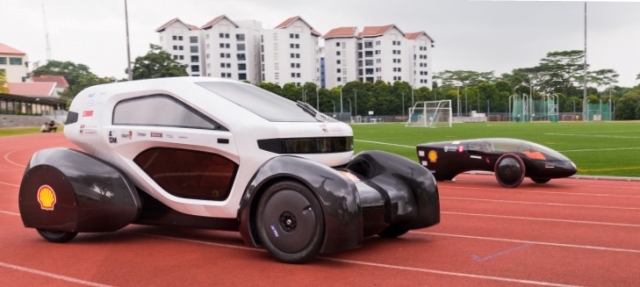Feb 4 2015
Singapore’s first urban solar electric car was recently built by the students of Nanyang Technological University (NTU). The car consists of a 3D-printed body shell that has 150 components.
The NTU Venture (NV) 8, as its known, is fitted on a carbon fibre single shell chassis, and will be a part of the race in the Urban Concept category at the 2015 Shell Eco-marathon Asia, scheduled to take place in Manila between 26 Feb and 1 March.
 Two new eco-cars to race at Shell Ec​o-marathon Asia
Two new eco-cars to race at Shell Ec​o-marathon Asia
Another student team from NTU has come up with the NTU Venture (NV) 9, a stylish three-wheeled racer capable of handling sharp corners with minimal loss in speed because of its exceptional tilting ability. Motorcycle racing was the inspiration behind the tilting concept. The NV9 comprises handmade silicon solar cells, and the team will be entering this car in the Prototype category at the Shell Eco-marathon Asia.
Both the eco-cars were designed completely by NTU undergraduates and took over a year to finish. The student teams hope that their cars will accomplish the highest fuel efficiency. The two teams were guided by Associate Professor Ng Heong Wah who stated that the students were bold to choose a challenging innovation rather than work on improving previous versions.
“Using the latest engineering techniques learnt from their studies in NTU, the students have developed innovations such as silicon solar cells that can be contoured to follow the car’s shape. This allows for maximum harvesting of the solar energy and a tilting mechanism in NV9 that can ‘lean’ in the direction of the turn to avoid losing speed,” Prof Ng said.
“We are extremely proud to have designed and assembled a 3D printed body shell for the electric car, which is Singapore’s first and probably Asia’s first 3D-printed concept car,” said Prof Ng. “The 3D printed car body was pushing existing technology to the limits and we are so pleased that it has paid off.”
Ilmi Bin Abdul Wahab, a year 4 computer engineering student who led the development of 3D-printed NV8, said, “We decided to go with a 3D-printed cabin made from lightweight plastic, as we wanted to maximise the internal space and driver’s comfort while still being able to keeping the weight to a minimum. Despite being an Urban Concept car, it is no slouch and can reach a top speed of 60 kilometres per hour, while maintaining low energy consumption.”
Team Manager of the three-wheeler NV9 team Winston Tan, a final-year electrical and electronic engineering student said, “We took our inspiration for the tilting mechanism from motorcycle racing, where racers would lean left or right during sharp turns to maintain their handling and speed. For the car’s body, we aimed for it to be as streamlined as possible. The resulting design looks like a fusion between a F1 race car and a glider plane, with an all surround canopy for increased visual awareness.”
The entire car building venture was handled by interdisciplinary and multi-partner teamwork. The NTU teams consisted of 16 students from different engineering schools. They used the Innovation Lab housed at the School of Mechanical and Aerospace engineering to accomplish this feat. Sponsors and institutions included Creatz3D, Stratasys, and The Singapore-MIT Alliance for Research and Technology (SMART).
The designer of the NV8 electric car, mechanical engineering student Kam Sen Hao, said, “Initially we wanted a supercar concept, but after taking into consideration the dimensional requirements for the competition, we ended up with a sensible cute micro-car with vertical opening doors, which will appeal to all ages.”
His co-designer, also from mechanical engineering, Ng Jun Wen, said “it was a challenge to assemble the shell of the car which was produced in different parts separately by the various 3D printers at NTU and at other sponsor companies.” He added “The printing and assembly took the team three months’ worth of effort.”
“For it to be lightweight, thin and yet strong, we integrated a honeycomb structure and a unique joint design to hold the parts together. When seen against the light, the structure has a translucent see-through effect, like a dragonfly wing. It is a sight to behold!” Ng said.
The annual Shell competition happens not only in Asia but across the Americas and Europe, thus motivating students to plan, build and use vehicles that provide both mileage as well as fuel efficiency.
“For Shell, sustainable mobility means helping our customers to be more fuel efficient while finding new innovations to deliver a cleaner transport system for tomorrow. The Shell Eco-marathon plays an important part by inspiring young generations of engineers and scientists to think creatively about fuel efficiency, and to put new ideas into practice,” said Mr Jason Leow, General Manager, Communications, Shell Singapore.
Participants can enter vehicles that use any one of the seven energy types - hydrogen (fuel cell), gasoline, diesel, battery electric, compressed natural gas (CNG), Shell Gas to Liquids (GTL), and Ethanol E100. The Prototype or Urban Concept categories are the only categories open to student teams. The Prototype Concept focuses on improved fuel efficiency via innovative design structures while the Urban Concept focuses on fuel-efficient vehicles that are "roadworthy”.